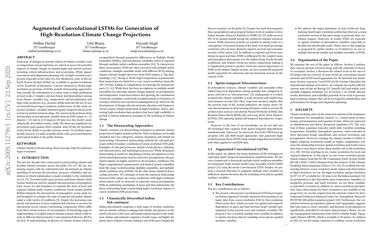Augmented Convolutional LSTMs for Generation of High-Resolution Climate Change Projections

Projection of changes in extreme indices of climate variables such as temperature and precipitation are critical to assess the potential impacts of climate change on human-made and natural systems, including critical infrastructures and ecosystems. While impact assessment and adaptation planning rely on high-resolution projections (typically in the order of a few kilometers), state-of-the-art Earth System Models (ESMs) are available at spatial resolutions of few hundreds of kilometers...
Current solutions to obtain high-resolution projections of ESMs include downscaling approaches that consider the information at a coarse-scale to make predictions at local scales. Complex and non-linear interdependence among local climate variables (e.g., temperature and precipitation) and large-scale predictors (e.g., pressure fields) motivate the use of neural network-based super-resolution architectures. In this work, we present auxiliary variables informed spatio-temporal neural architecture for statistical downscaling. The current study performs daily downscaling of precipitation variable from an ESM output at 1.15 degrees (~115 km) to 0.25 degrees (25 km) over the world’s most climatically diversified country, India. We showcase significant improvement gain against three popular state-of-the-art baselines with a better ability to predict extreme events. To facilitate reproducible research, we make available all the codes, processed datasets, and trained models in